A recent post over at the Transbay Blog on the old B-Geary streetcar line inspired us to republish and update the following story from our Fall 2002 member newsletter, Inside Track. In a previous issue, we had looked at the decisions made — and not made — that doomed streetcar service on the original F-line (today’s 30-Stockton bus) and the old H-line (on Van Ness and Potrero Avenues). Their demise at the beginning of the 1950s left San Francisco with just seven streetcar lines, down from a high of around 50. And the clock was ticking for two of them…
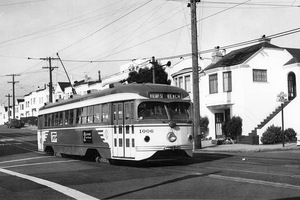
Torpedo tease. For a brief time, Muni ran some of its double-end modern cars in regular service on the B-Geary, but only on Saturdays. Here’s ‘torpedo’ PCC No. 1006 on 33rd Avenue bound for Playland-at-the-Beach around 1952. Will Whittaker photo.
Muni’s roots were firmly planted on Geary. Its first ten streetcars headed west from the foot of Geary at 12 Noon, December 28, 1912, penetrating deep into the sparsely-developed Richmond District via that thoroughfare, and soon reaching Ocean Beach by jogging over on 33rd Avenue, Balboa, 45th, and Cabrillo.
Muni’s nerve center was on Geary, too — its first car house, with headquarters space added on top, sat just about halfway between the Ferries and the Beach, at Geary & Presidio Avenue. The car house served more than just the Geary lines. The cute ‘dinkies’ of the E-Union line were tucked away downstairs. A fleet of ‘battleships’ or ‘boxcars’, as Muni’s original bulky streetcars were variously called in early years, cruised off to serve other lines, including the N-Judah and J-Church, as well as the F-Stockton and D-Geary-Van Ness. Though a trolley coach division was added behind the car house in 1949, Muni’s top executives still worked, literally, right on top of streetcars.
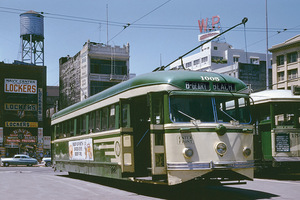
Magic Carpet ride. Along with ‘torpedos’ No. 1006-1015, Muni sometimes dispatched its five 1939 PCC-look-alike ‘Magic Carpet’ cars on the B on Saturdays. Here’s No. 1005 ready to depart East Bay Terminal, signed for the B, but wait a minute. The paint scheme shows that the car has been single-ended, which happened after modern cars were pulled from Geary Saturday service. So this is probably a railfan trip. Clark Frazier photo.
But by 1951, the City Charter requirement that streetcars operate with crews of two was putting pressure on the remaining lines. Buses only required one operator, and Muni had already converted all the streetcar lines it inherited from our namesake, the Market Street Railway Company. Four of Muni’s own streetcar lines, the D, E, F, and H, were also newly ‘bus-ified’. And by 1952, buses had even replaced streetcars nights and Sundays on all seven surviving streetcar lines (except the Market Street and Twin Peaks Tunnel section of the L). Many riders, accustomed to the streetcars, were unhappy, but Muni management, citing labor costs, felt they had no choice.
Politicians and the public in that era were not accustomed to subsidizing mass transit. It was expected to ‘pay its way’ through farebox revenues, and until that time, Muni had. But more and more lines were slipping into operating deficits. In the 1952-53 fiscal year, for example, Muni figures showed that the streetcar lines collectively lost almost half a million dollars, while the new trolley bus routes (which all replaced streetcars) made an operating profit of almost two million dollars. Of the seven streetcar lines, only the B and C made an operating profit. (The K and L, on the other hand, were the biggest losers in the entire Muni system.) And the B-bus, which operated nights and Sundays, made a significantly higher profit per operating hour than the B and C streetcars it replaced.
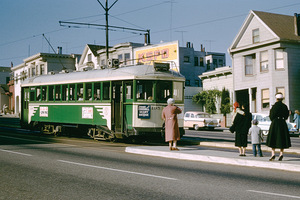
Modern median. In 1948, Muni rebuilt the B-line tracks between Presidio and Divisadero when Geary was widened there. The result was a fast efficient operation that could have easily been extended to the subsequent Geary Expressway, later built through the Western Addition. Clark Frazier photo.
Muni had only fifteen modern streetcars at this point. But using the last of the 1947 bond issue funds, they were able to buy 25 more PCCs, numbered 1016-1040. (These turned out to be the last PCCs ever built in North America. Ten of these cars have been preserved for future restoration by Muni, with Market Street Railway’s help.) Muni hoped to run these cars with a single operator, but voters said “No” in late 1951, so they were set up as two-operator cars. At first these cars were assigned to Geary Division, but not to the B-Geary line. Rather, they worked the K, L, and N lines.
PCCs on the B — briefly
As Muni’s first single-end streetcars, though, they had no way to turn around at the Geary car house. So before going into service on one of the Market Street lines, these ‘Baby Tens’ had to go all the way out to Ocean Beach on the B, take the terminal loop, and make a full trip inbound, signed “B-Geary/Bridge”. This gave some riders the belief that these fast, quiet cars were on their line to stay. A similar impression came from the double-ended PCCs that were occasionally assigned to Saturday runs on the B.
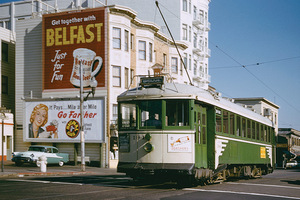
Hollowed ground. The Geary Expressway included a gouged-out underpass at Fillmore Street. The ramp starts just past where the streetcar is, at Steiner. The buildings on the left were all demolished for the Expressway. Clark Frazier photo.
Not for long. By 1953, all 40 of Muni’s modern streetcars (35 PCCs and five PCC look-alike ‘Magic Carpets’) were ensconced at Geneva Division, completely divorced from operation on Geary. Some speculate that this was part of a conscious plan to drive streetcars from Geary, but it may simply be that Muni officials knew there was no near-term prospect of having enough PCCs to completely modernize Geary service — more than 75 cars were needed for the B and C lines (by this time the C was essentially a short-turn B, turning north for just two blocks on Second Avenue and terminating). Besides, the fully enclosed PCCs were far more comfortable to ride through the tunnels than the drafty ‘boxcars’, and faster too.
So Geary Division was again home only to the old-style streetcars. Some of these cars were ‘only’ 25 years old, and all had been kept in good shape. Muni installed doors on the formerly open ends of some of the old cars and upgraded them cosmetically as well. Muni management still hoped to win voter approval to operate its entire streetcar fleet with single-person crews, significantly cutting labor costs, but the carmen’s union was staunchly opposed to changing the status quo for the old cars. A compromise, finally approved by voters in 1954, allowed only newer-type streetcars to have single operators. The PCCs were quickly converted to one-operator, and Muni began thinking about additional PCCs. But no one was building new PCCs, and anyway, the City did not have the capital to replace all its old streetcars — or for that matter, its aging buses either.
Auto mania
About this time, ‘auto mania’ reached its peak in San Francisco. Many streets downtown were made one-way, including the pair that flanked Geary — Post and O’Farrell — dooming the inner end of the wonderful O’Farrell, Jones, and Hyde Street cable car line in the process. Big automobile garages were built for shoppers and commuters. Numerous proposed freeways slashed across planners’ maps. In this context, many thought the old-fashioned streetcars assigned to Geary looked more and more antiquated, almost like the cable cars on Powell.
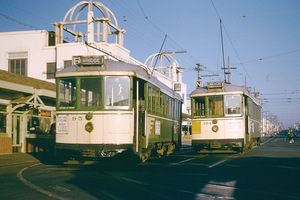
Which line is it anyway? Muni scheduled a few odd runs on the B-line. Here, an N-Judah car reverses at Playland next to a B. This run pulled out from Geary and Presidio, ran to the Beach, then all the way to East Bay Terminal before actually heading out the N to begin its “normal” day. Clark Frazier photo.
Certainly that belief was shared by many merchants on Geary Boulevard, the wide section of the thoroughfare running westward from Masonic Avenue through the Richmond. They were lobbying City Hall for a ‘Great Wide Way’, replacing streetcars with buses … and more parking for automobiles.
Planners who were eying the part of Geary between the Richmond and Downtown echoed this pro-auto sentiment. The Western Addition had been a vibrant community of Victorian homes before World War II. The section along Geary was populated mainly by Japanese-Americans. When World War II started, they were infamously hauled away to internment camps. African-American newcomers, who had come west to work in war industries, largely took their place. By the mid-1950s, there was talk of ripping down the Victorians along that part of Geary to gouge out a broad expressway to get automobiles downtown more quickly.
But the streetcars were in the way. Certainly the tracks could be rebuilt, as they were in 1948 when Geary was widened between Masonic and Divisadero. But, said the critics, it would be expensive, and why keep running those clunky old ‘trolley cars’ anyway? (In the San Francisco of those days, ‘streetcar’ had been the universally used term for the vehicles. Opponents began using ‘trolley cars’ as an epithet to conjure up the slow and inefficient ‘Toonerville Trolley’ of cartoon fame.)
Subway dreams
One last factor in the mix … rapid transit. The demand was certainly there: except for Market Street, Geary was the busiest transit corridor in the city. While the western half of Geary was wide, the eastern half was narrow and congested. Muni’s first 43 streetcars were built narrower than usual, specifically for operation on Geary (though most were quickly switched to the even more congested F-Stockton line when it opened). A subway under Geary downtown and through the Western Addition, surfacing at Steiner Street, was proposed as early as 1936. It would have used conventional streetcars, and, had it been built — at a then-projected cost of $13 million — it might have forestalled the automobile expressway. But it was the depths of the Depression, and there was just no money available.
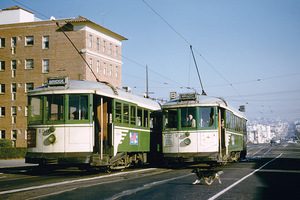
Which line is it anyway? Muni scheduled a few odd runs on the B-line. Here, a J-Church at 33rd and Geary is making the short turn to head inbound, one of a few J runs that followed this practice. Since they always used double-end cars, these runs could have headed straight downtown from the car barn. The extra trip on the B may have been to provide additional rush hour service on the heavily traveled line, or just to fill out the schedule for the run. Clark Frazier photo.
By the mid-1950s, this concept had evolved into a scheme for a heavy-rail subway carrying regional trains from the East Bay to the Golden Gate Bridge and into Marin County. The future of transit on Geary became an issue in the mayoral election of 1955. The winner, George Christopher, had pledged to keep streetcars on Geary at least until rapid transit plans were further advanced.
About this time, a civic committee led by hotelier Ben Swig came up with a creative financing idea for Muni: lease vehicles instead of buying them. After a struggle, they found one bus builder, Mack, willing to go that route. But streetcars were something else. Many properties around the country were converting to buses, and there were used PCCs available for sale, though not (at that time) for lease. And after defeat of another bond issue in 1953, Muni had no money to buy.
Good-bye, B
The combination of pressures — auto mania, the high labor cost of two-operator streetcars, the desire of planners to bulldoze the Western Addition, and the promise of a subway — combined to change Christopher’s mind after he took office. Muni’s oldest streetcar corridor was doomed. Just before 1956 ended, so did the B and C lines. Railfans and many residents mourned to no avail. Geary was now served by the 38- line, operated by the new, leased, Mack diesel buses.
Too little, too late
At just this juncture, Muni finally found some PCC streetcars it could afford. St. Louis Public Service, which was undergoing its own bus conversion, agreed to lease Muni 66 (ultimately 70) 1946-vintage PCCs. This gave Muni (barely) enough one-operator streetcars to retire all the remaining two-operator ‘boxcars’ on the remaining five lines by 1958. But it wasn’t enough to save streetcars on Geary.
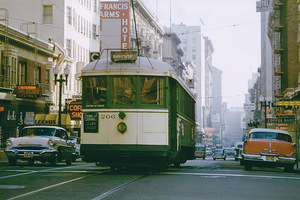
The big squeeze. When Geary Street was two-way downtown, it was a squeeze for Muni’s full width ‘Iron Monsters’. This problem was recognized as soon as the line opened in 1912, and repeated proposals for a subway beneath Geary followed. Clark Frazier photo.
Soon after, ‘auto mania’ subsided in San Francisco. Outraged by the ugly Embarcadero Freeway, which opened just as the B was disappearing, and by proposals to cut freeways through Golden Gate Park, San Francisco’s ‘freeway revolt’, the first of its kind in the nation, lashed back at the ‘asphalt jungle’. However, with the increasingly powerful Redevelopment Agency as the spearhead, the Geary Expressway did get built in the early 1960s, at the cost of hundreds of homes.
Perhaps if the freeway revolt had occurred a few years sooner, perhaps if one-operator streetcars had been approved a few years sooner, perhaps if leased PCCs had been available a few years sooner … perhaps if these things had happened, the B might have survived as a streetcar line. But they didn’t happen. The view of the powerful interests that ruled San Francisco at the time was that streetcars were out of step with modern times, and so they only survived where it was too difficult to replace them with buses: the tunnel lines, and the J-Church, where neighbors rallied in defense of their preferred transit mode.
What might yet be
Still, the 38-line bus was seen as an interim operation. The original BART proposal in the late 1950s included a line under Geary and across the Golden Gate Bridge, but Marin County pulled out of the district, killing that concept. A Muni Metro Geary subway was part of a rapid transit package put to San Francisco voters in 1966, but they said “No.”
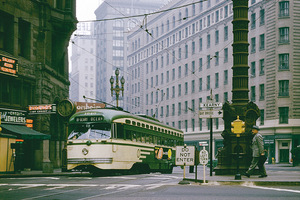
Too late. The last PCC ever built in North America, car No. 1040, carries a group of railfans out Geary for one last run the day after the line shut down for passenger service in 1956. If one-operator cars like this could have been acquired in sufficient numbers and assigned to Geary in the early 1950s, the line might have been saved. But it wasn’t to be. Clark Frazier photo.
Muni seriously proposed a Geary subway and light-rail line again in the late 1980s as part of a sales tax increase ballot measure, which also included a light rail proposal on Third Street. Voters approved, but a tepid reception among Geary residents and businesses led to further deferral of the Geary subway dream.
When we first published this story in our member newsletter in 2002, Muni was talking about a Geary subway again, at least conceptually. Muni’s “Rapid Transit Vision for San Francisco” called for a Geary subway (Downtown to Cathedral Hill) and surface (west of Laguna) light-rail line “next in priority for major investment behind the Central Subway” (under Third/Fourth and Stockton Streets). Since that time, the alternative concept of “bus rapid transit” has gained the (pardon the expression) inside track for Geary, but rail advocates hope it might be a stepping stone to a subway-surface line served by light rail vehicles. Should that ever happen, there will be considerable sentiment to restore the ‘B-Geary’ designation as a nod to this major piece of Muni history.
here’s a picture of 1005 in 1972, though i’m unsure of the exact date:
http://world.nycsubway.org/perl/show?16127
@WWT
Thanks, we are aware of the issues with our commenting system, and are working to resolve them. In the future, please contact us directly via email (blog@streetcar.org) to let us know about any technical issues you’re experiencing, rather than in the comments. Thanks.
The car in the second photo has it’s wheels completely covered, are any of the streetcars talked about in the last post that are about to be restored going to have that look?
The “wheel covers” (actually called skirts) were unique to the “Magic Carpet” cars (1001-1005) in San Francisco. The cars being restored are later double-end cars (1006-1015 class), and they didn’t have the skirts, so no.
According to “Inside Muni” all of the “Magic Carpet” cars except 1003 were scrapped by 1960. Judging from the automobiles in the photo, it was taken around 1956. Sometimes photos that have been copied will show the date when the copy was made (I had a steam locomotive photo taken as a slide in 1959 printed in 1964; when a steam fan saw the 1964 date he couldn’t believe it until I explained the full story)
1003 is preserved at Rio Vista Jct. in operating condition; it has been there since 1961. It was in MuniLand for about 22 years, and has been a museum piece for 47. One of its unusual features is that it has a “Cineston” hand-operated controller, rather than the typical PCC pedal controls. Cinestons are more often seen on Chicago rapid transit cars.
I still don’t know why Muni decided to scrap the Magic Carpets, they could have ran on the F-line today…
@Whole Wheat Toast had Muni been planning 50 years ahead, they would have kept rail service on Geary.
Probably one of the reasons for scrapping four of the five Class C (Magic Carpet) cars was that they were air-electric, while all of the “true” PCC’s at Muni were (and are) all-electric, with no air brake components. Note that they were not retired until all the St. Louis “hand-me-down” PCC’s were on the property. Also note that the surviving “C”, 1003 has Brill, rather than PCC trucks; the cars were considered “experimental” although they spent many years in revenue service. One of the things I learned reading about Muni of that era was that there were proposals to convert all the electric streetcar lines to trolley-bus operation. This would have left the cable-car lines as the only street railway service in MuniLand, and this whole discussion (and Market St. Ry. III) would have never happened. Let us be thankful that, exasperating as it can be, Muni kept the faith with electric streetcars and even extended lines into what we have today.
Bob Davis
San Gabriel CA
What difference does it make to talk about “What Might Have Been”? The Geary streetcar was stripped out and the Geary merchants bitterly oppose any new light rail/subway.
So everyone in the Richmond can whine and complain all they want, but until you quell the extreme NIMBYism and can organize to support a rail project, it will never happen.
Chinatown is at least behind the Central Subway; the people along Geary cannot stand Muni and do not want a subway/rail, I am sad to say. It will cost billions, there is no getting around that, but they do not want the disruption & hence they can’t get the goodies either (quick transport). Maybe you people who complain about the Central Subway and who live in the Richmond should use 1/20th of your time quelling the extreme NIMBYism that puts any Geary plan back. If the Geary folks and Richmond folks wanted a subway or rail, they could easily organize and lobby Pelosi for it.
“…rail advocates hope it might be a stepping stone to a subway-surface line served by light rail vehicles.” – That’s the whole point, the only people who support rail down geary are rail-advocates with pipe dreams and people who live in the Richmond District who want to get into downtown quicker. That is not a winning coalition without the Geary merchants.
@thamsenman
The primary objection to Muni modernisation on Geary is that the disruption would likely put many of the businesses along the strip out of business.
There is also a primary clash on Geary Blvd between commuters and shoppers.
Shoppers primarily live in the Avenues and use their cars as shopping trolleys to carry their purchases home.
The biggest problem is the Bus Rapid Transit freaks.
With BRT you get all the construction disruption of a light rail installation with little of the potential benefit.
The BRT consultation meetings were a farce. The girls and boys on that team have already made up their minds and do not intend to build in any provisions for light rail.
Last time I checked they were saying that the incremental cost of making the BRT installation rail-ready was too high.
If they get away with their bus coup there will be no rail on Geary in our lifetimes.
The business community could not survive two construction tie-ups on the Blvd.
re pic “Which line is it,anyway?”
The caption speculates that one J car is shunting to provide an additional rush hour trip on the B line.
Look at the sun and the location. It is afternoon. George Washington High School (32nd Ave and Anza) students get on at the next stop.
The car is probably on a school tripper.
Note that that car is still in service on the F line.
What I’ve never understood is why the MUNI has never made the B – Geary a trolley coach line. With the level of ridership and service on the line, trolley coaches would certainly be justified. True, not as good as street car or light rail, but better than Diesel buses. But articulated trolley coaches with off-wire capability would be ideal on the B line.
While I’m not an advocate of BRT {Bus Rapid Transit}, it could be built using vehicles with trolley poles and overhead trolley wires. BRT seems to be the desired scheme for the B these days.
BRT or Bus Rapid Transit has been proposed for Van Ness, and in grand San Francisco style has been talked nearly to death, which is good, as it has come to be realized that while BRT offers substantial savings in construction, over time its costs are higher than rail transit–buses don’t last as long–and it doesn’t draw the sort of development along its route that rail transit encourages.
It would be nice to think that after all this talking, San Francisco would utilize the newly available facts to drop the idea and begin planning for Van Ness rail service, but, of course this IS San Francisco, and, having talked it this long, someone might just feel we might as well build it…